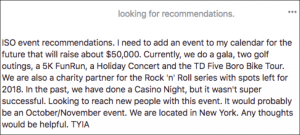
Photo by alex bracken on Unsplash
Sometimes it seems like all the nonprofit sector talks about is donor retention. Do this. Don’t do that.
Of course, there’s a reason for that. Your organization’s donor retention rate speaks volumes about the health of your fundraising program.
When your donor retention rates are higher, your fundraising costs go down. As donors get to know you and love you, revenue goes up. Way up.
When retention rates are low, fundraising is always a struggle. You’re constantly swimming upstream.
But the rallying cry continues. “What about new donors, Pam? We need new donors!”
I agree. Every nonprofit organization needs to include tactics and a budget for new donor acquisition into their yearly fundraising plan.
But how?
Begin by establishing the internal systems to attract, nurture and grow the donors you do have. Your first focus should always be on fixing your broken systems.
What kind of welcome does a new donor receive? Are they mailed a Welcome Pack? Or a thank you email that ends up in spam?
One of the smartest practices you can embrace is to call every new donor on the phone just as soon as that gift comes in.
Make a habit of it.
1. Know Who Your Best Donors Are
Early on in my career, I met with someone who was interested in hiring me for consulting. One of the first questions I asked him was “who would support your organization?” In other words, why would someone give you their hard-earned money?
“Why EVERYONE would support us if they knew about us!” he proclaimed.
Their mission? To support theological students studying for the priesthood.
A worthy mission, yes. But a fairly narrow niche when it comes to soliciting donor support.
Before you think about new donor acquisition, you need a solid understanding of who would be attracted to your mission.
Begin by taking a look right in your own database. What are their demographics? Where are they located? What’s their average age? How were they acquired (online, direct mail, events, other)?
How would you identify your organization’s best donor? Download my free template and spend some time envisioning your “tarquet.” Defining your donor will go a long way toward deciding what tactics are best for your organization.
2. Who Do You Know?
It’s surprising how many people we come into contact with in the course of the day. Start by taking a good hard look at who resides within your circle and who you might nurture. Download this free exercise to use with your board and staff.
3. Begin With Your Board
Early on in my own fundraising career, I trained under the Benevon method. I wasn’t a fan of the overall model, finding it far too transactional. But one big takeaway for me was their “Point of Entry” event.
This is where one board member might host a small cocktail party in their home to introduce their friends to your mission. When I’ve used this tactic, we’ve often had a speaker (often a beneficiary of the services) or a presentation. Everyone should be comfortable talking about the organization. No one should ever feel compromised.
Pros: it’s free.
Cons: Your follow-up is critical and is something that you’ll want to establish prior to the event. If you don’t already have your “Ask/Thank/Report” systems in place, it may not be worth your while.
4. Referrals
In my first fundraising job, I faced the dismal prospect of an elderly dying donor base and no budget for acquisition. Remembering the marketer’s best advice of “referrals, referrals,” when I ran my first campaign, I did something a little unusual.
When a check above a certain amount came in from a long-time donor, I sent a thank you letter along with a very personal message. In my note, I introduced myself, noted their loyalty, and asked if they might share our work with a friend, neighbor or family member who might also be interested. I included a few “pass it on” packs.
This tactic led to roughly 100 new donors coming on board that year. And several donors called in, requesting more packs!
Pros: It’s free.
Cons: You’ll need to spend some time creating a sensitive ask. And, again, you’ll need your back-end systems in place.
5 Crowdfunding
Crowdfunding can be a tremendously successful way to get started fundraising — and to bring on new donors. A campaign can be put together quickly (in as little as 10 days) and, according to Fundly, the average amount a nonprofit crowdfunding campaign raises is $9,237.
If you’re considering crowdfunding, download Week One from our Basics & More Crowdfunding class to get started.
Pros: Easy to get started.
Cons: Fundly notes that only 22% of all crowdfunding campaigns actually meet their goals. You should have your systems in place to turn those one-time donors into repeat donors.
6 Direct Mail Acquisition
If your audience is primarily local or you have a very specific niche, this could be your best bet. Yes, it’s possible to DIY. But I don’t recommend it. Direct mail acquisition is a tricky process. In our Direct Mail Masterclass, I strongly recommend outsourcing your first direct mail acquisition to a qualified consultant. They’ll know to get you the best list, the best pricing, and to have your follow-up in place.
Pros: If yours is a community organization and much of your donor base is local, direct mail acquisition can be an excellent way to bring new donors into the fold.
Cons: Again, the real value lies in the follow-up. If you do hire an outside consultant, make sure that the follow-up pieces are included in your contract.
7. Events
Ah, the million-dollar gala…
Nonprofit events can and do raise money. But they are also typically the lowest ROI of any fundraising activity. And we’ve all heard the story about the nonprofit accustomed to raising $1 million with their annual gala. When COVID hit and they took their event virtual, they raised all of…$4,000.
Actual post seen in a Facebook group (let’s discuss the average length of tenure of nonprofit fundraisers…):

Events are exhausting and typically low yield. Smart fundraisers focus on sponsorships.
Pros: Some find events fun and they’re probably the easiest way to involve the board and staff.
Cons: You can get on a treadmill. And there’s no way off. You’ll want to always have your backend systems in place to steward and nurture event attendees and transition them to donors.
8. Grow Your Email List
The goal of growing your email list should play a primary role in your yearly fundraising plan. Always. It’s more important than your Facebook, TikTok, or Instagram followers combined.
What value are you offering to your prospective supporter?
Perhaps a free ebook, signing a petition, and getting creative like Children’s Medical Center did here. New Beauty magazine has an interesting promotion. If you text the word BEAUTYPASS to the number 52705, every Friday they send out texts for free products, you just pay the $10.95 shipping. It’s typically a product valued at anywhere from $65 on up. Arts organizations might offer the opportunity for a free ticket to a performance.
Always put opt-in forms on your organization’s Facebook page.
9 Empower the Donors You Already Have to Fundraise on Your Behalf
Consider how you’re empowering your current donors to fundraise on your behalf. I’m advising every nonprofit I consult with to develop a guide similar to this one, from the Soi Dog Foundation.
10. Speaking Engagements
One of the oldest methods of fundraising still works today. In fact, if you’ve read the story of Russell Conwell, you know that he gave that speech 6,152 times around the world. It was the proceeds from that speech that created Temple University.
I’ve worked with dozens of nonprofit organizations that have built their core base of individual donors through speaking engagements. They’ve spoken at Rotary meetings, Chamber of Commerce meetings, churches, and business and networking events.
Michele Rickett, a Basics & More alum and founder of She Is Safe, a nonprofit that works to prevent, rescue and restore women and girls from abuse and slavery in high-risk places around the world, has spoken at hundreds of churches. A former client’s 40-year-old nonprofit started on a shoestring budget and went on to amass a huge donor and volunteer base through the power of public speaking, largely in churches.
Remember, it costs six times as much to acquire a new donor as it does to retain a current donor. Always work on your retention systems first.
There you have it! Some of my favorite ways to grow your organization’s donor base.
Rather than embrace every method, I suggest putting your focus on one to three tactics that are right for your organization.


















 I can’t wait to meet with you personally.
I can’t wait to meet with you personally.
Comments on this entry are closed.